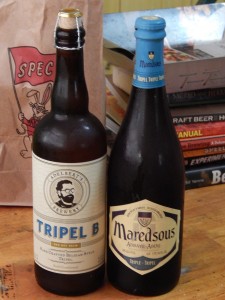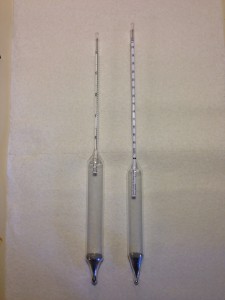 The recipe for tripel is downright simple. And, wort production is not that elaborate (at least compared to, say, a multiple decoction mash). Fermentation, however, can get a bit tricky. [Read more…]
The recipe for tripel is downright simple. And, wort production is not that elaborate (at least compared to, say, a multiple decoction mash). Fermentation, however, can get a bit tricky. [Read more…]
Archives for August 2015
Tripel (IV: Fermentation)
What I Believe (Post 500)
 This is the 500th post to Beer and Wine Journal, minus a couple time-sensitive posts that were deleted when they were no longer relevant. (I know you’re all interested the minutiae of how we counted we that.) Most of what is posted here is nuts and bolts homebrewing stuff, with the occasional food-related update. I’ve also published a very few opinion pieces. For the 500th post, I’m going to tell you what I believe. (Basically, I believe I’ll steal a comedy bit from Steve Martin.) [Read more…]
This is the 500th post to Beer and Wine Journal, minus a couple time-sensitive posts that were deleted when they were no longer relevant. (I know you’re all interested the minutiae of how we counted we that.) Most of what is posted here is nuts and bolts homebrewing stuff, with the occasional food-related update. I’ve also published a very few opinion pieces. For the 500th post, I’m going to tell you what I believe. (Basically, I believe I’ll steal a comedy bit from Steve Martin.) [Read more…]
Forced Fermentation Test (II: Practice)
 Last week, I described the basic idea behind the forced fermentation test. Basically, you overpitch a small sample of wort, and ferment it at high temperature. The sample will reach it’s final gravity (FG) before your main batch of beer. Knowing the FG of the sample will tell you what the FG of the your beer will be. This can be good to know when you are deciding whether to bottle. Here’s how to perform the test. [Read more…]
Last week, I described the basic idea behind the forced fermentation test. Basically, you overpitch a small sample of wort, and ferment it at high temperature. The sample will reach it’s final gravity (FG) before your main batch of beer. Knowing the FG of the sample will tell you what the FG of the your beer will be. This can be good to know when you are deciding whether to bottle. Here’s how to perform the test. [Read more…]
Tripel (III: Wort Production)
 The recipe for a tripel is simple, it’s almost the equivalent of the “recipe” for scrambled eggs. However, as with preparing eggs, success lies in the freshness of the ingredients and in the details of the preparation. When brewing a tripel, your main task on brewday is to make a highly fermentable wort. [Read more…]
The recipe for a tripel is simple, it’s almost the equivalent of the “recipe” for scrambled eggs. However, as with preparing eggs, success lies in the freshness of the ingredients and in the details of the preparation. When brewing a tripel, your main task on brewday is to make a highly fermentable wort. [Read more…]
Forced Fermentation Test (I:The Basic Idea)
 Brewers, especially new brewers, may wonder what the final gravity (FG) of their beer should be. Perhaps their barleywine stopped fermenting at SG 1.022 and they are wondering if it’s done or the fermentation is stuck. This is something the FG alone can’t tell you.
Brewers, especially new brewers, may wonder what the final gravity (FG) of their beer should be. Perhaps their barleywine stopped fermenting at SG 1.022 and they are wondering if it’s done or the fermentation is stuck. This is something the FG alone can’t tell you.
Established recipes frequently list an expected FG, and these should be a good estimate if you follow the recipe exactly. If, however, you’re formulating your own recipe — or modifying an existing one — the FG depends on three main variables. First, every yeast strain has a different range of apparent attenuation. Secondly,grain bills can be mashed to yield more or less fermentable worts. (Likewise, different malt extracts yield worts of differing fermentabilities.) And finally, some kettle adjuncts are more or less fermentable than wort made from mashed grains or dissolved malt extract. Table sugar (sucrose), for example, is 100% fermentable. In contrast, milk sugar (lactose) is not fermentable by brewers yeast. Although it may be possible to calculate a likely FG, you can determine experimentally what your FG will likely be with the forced fermentation test. [Read more…]
My One Good Fred Story
 Homebrewers today live in a world full of information. There are homebrewing books, magazines, websites, and internet forums. In addition, there are homebrewing clubs to join and contests to enter. But it wasn’t always that way.
Homebrewers today live in a world full of information. There are homebrewing books, magazines, websites, and internet forums. In addition, there are homebrewing clubs to join and contests to enter. But it wasn’t always that way.
In the United States, in the late 1970s, there was nothing. In 1979, Jimmy Carter signed a bill making the homebrewing of beer legal in the US. Home winemaking was already legal, and there was a small community of home winemakers. But home beer brewing was clandestine and not widely practiced, although most people probably “knew a guy who knew a guy.” [Read more…]
Tripel (II: Recipe)
 The recipe for a tripel is simple. You’ll need enough Pilsner malt, and roughly 20% sucrose (table sugar), to reach your target original gravity. The Beer Judge Certification Program (BJCP) gives this range as OG 1.075–1.085. Plus, noble hops — all added near the beginning of the boil — to reach your target level of IBUs. The BJCP gives this as 20–40 IBUs. And finally, an attenuative yeast, with a moderately “spicy” Belgian character, to yield a low final gravity (FG). The BJCP gives this as 1.008–1.014 for a corresponding alcohol content of 7.5–9.5%. And that’s it.
The recipe for a tripel is simple. You’ll need enough Pilsner malt, and roughly 20% sucrose (table sugar), to reach your target original gravity. The Beer Judge Certification Program (BJCP) gives this range as OG 1.075–1.085. Plus, noble hops — all added near the beginning of the boil — to reach your target level of IBUs. The BJCP gives this as 20–40 IBUs. And finally, an attenuative yeast, with a moderately “spicy” Belgian character, to yield a low final gravity (FG). The BJCP gives this as 1.008–1.014 for a corresponding alcohol content of 7.5–9.5%. And that’s it.
What’s New?
 So you started brewing awhile ago, and you’ve gotten pretty good at it. You’ve brewed some ales, and some more ales. You’ve added more hops, and even more hops, to some of your beers and they were great. But maybe you’ve been noticing a certain sameness creeping into your brewdays and want to try something new — but what is there?
So you started brewing awhile ago, and you’ve gotten pretty good at it. You’ve brewed some ales, and some more ales. You’ve added more hops, and even more hops, to some of your beers and they were great. But maybe you’ve been noticing a certain sameness creeping into your brewdays and want to try something new — but what is there?
For intermediate brewers, there are a ton of “new” things you can try. Few of these are new to brewing as a whole, but most are underappreciated in the homebrewing community and mostly attempted only by advanced homebrewers. If you’re looking to try something new to you, consider the following options. [Read more…]
Tripel (I:Water)
Tripel is a strong, golden ale that originated in Belgium. It’s very similar, in fact, to Belgian strong golden ales, like Duvel or Delirium Tremens. Westmalle Tripel, Tripel Karmeliet, and Chimay Cinq Cents (Chimay White) are three well-known tripels that are available in the US. Examples of tripels brewed in the US include New Belgium Trippel, Allagash Tripel Reserve, and Victory Golden Monkey. Notice that the spelling isn’t entirely standardized. New Belgium spells their version “trippel,” while some Belgian breweries label theirs as “triples.”
The Westmalle Trappist Brewery made tripels popular and the designation sets their 9.5% ABV Tripel apart from their 7% ABV Dubbel (double) and their 4.8% “single” beer (called Extra, and not generally commercially available). In addition to being an indication of strength, by convention, tripel always designates a pale beer while dubbels are always dark beers.
There are several challenges to brewing a tripel, and this makes it a great brewing experience for homebrewers used to brewing English-style ales who are looking for something new to try. [Read more…]
Beer News (July 23–August 3)
 Alright, as always, let’s kick this off with a “listicle” (an article in the form of a list) or two. HuffPo lists the 10 Best Brewery Tours, in their estimation, and The Street gives 10 Cities Where Craft Beer is Taking Off.
Alright, as always, let’s kick this off with a “listicle” (an article in the form of a list) or two. HuffPo lists the 10 Best Brewery Tours, in their estimation, and The Street gives 10 Cities Where Craft Beer is Taking Off.

Recent Comments